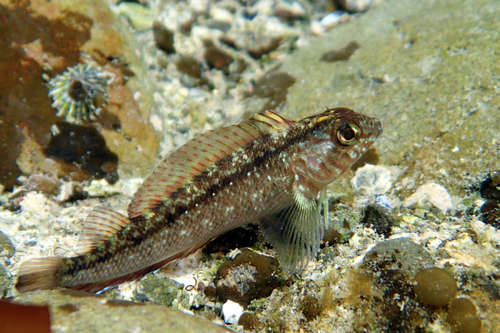Common Threefin, Forsterygion lapillum Hardy 1989

A Common Threefin, Forsterygion lapillum, in Frank Kitts Lagoon, Wellington, New Zealand. Source: d_kluza / iNaturalist.org. License: CC by Attribution-NonCommercial-NoDerivatives
The Common Threefin, a native of New Zealand, was accidentally introduced to Australia, presumably via the ballast water of ships. It was discovered in Corio Bay, Port Phillip, Victoria during the 1990's.
Females and juveniles are greyish with a distinct black stripe from above the eye to the tail. Males are black, often with reddish second and third dorsal fins.
Common Threefin, Forsterygion lapillum Hardy 1989
More Info
|
Distribution |
Introduced to Port Phillip, Victoria, from New Zealand. The species is abundant in New Zealand where it occurs on shallow rocky reefs, around jetties and in tide pools to 10 m. |
|
Features |
Dorsal fin V-VIII + XVIII-XXIV + 9-13; Anal fin II, 19-26; Caudal fin 13; Pectoral fin 17-19; Pelvic fin I, 2; Lateral line (upper) 19-27, (lower) 16-25. |
|
Size |
To 8 cm. |
|
Biology |
The sexes are separate and fertilization is external. Females spawn demersal eggs onto hard substrates, and males protect the clutch until hatching. The larvae are pelagic for about 50 days before settling onto macroalgae. |
|
Etymology |
The specific name is from the Latin lapillus (= pebble), in reference to the habitat of this species "abundant among patches of cobbles or small loose boulders..." |
|
Species Citation |
Forsterygion lapillum Hardy 1989, Journal of Natural History 23(3): 504, figs 1A, 5. Type locality: Goose Bay, Kaikoura, New Zealand. |
|
Author |
Bray, D.J. 2020 |
|
Resources |
Common Threefin, Forsterygion lapillum Hardy 1989
References
Clements, K.C. 2003. Triplefins. pp. 160–167 in Andrew, N. & Francis, M. (eds) The Living Reef. The Ecology of New Zealand’s Rocky Reefs. Craig Potton Publishing, Nelson.
Clements, K.D. 2014. Forsterygion lapillum. The IUCN Red List of Threatened Species 2014: e.T178904A1545966. https://dx.doi.org/10.2305/IUCN.UK.2014-3.RLTS.T178904A1545966.en. Downloaded on 27 November 2020.
Feary, D.A. & Clements, K.D. 2006. Habitat use by triplefins (Tripterygiidae) on rocky reefs in New Zealand. Journal of Fish Biology 69(4): 1031-1046.
Feary, D.A., Wellenreuther, M. & Clements, K.D. 2009. Trophic ecology of New Zealand triplefin fishes (Family Tripterygiidae). Marine Biology 156(8): 1703-1714.
Francis, M.P. 1996. Geographic distribution of marine reef fishes in the New Zealand region. New Zealand Journal of Marine and Freshwater Research 30(1-2): 35-55.
Fricke, R. 1994. Tripterygiid fishes of Australia, New Zealand and the southwest Pacific Ocean (Teleostei). Theses Zoologicae 24: 1–585.
Gomon, M.F. 2008. Family Tripterygiidae. pp. 684-693 in Gomon, M.F., Bray, D.J. & Kuiter, R.H. (eds). Fishes of Australia's Southern Coast. Sydney : Reed New Holland 928 pp.
Hardy, G. 1989. The genus Forsterygion Whitley & Phillipps, 1939 (Pisces: Tripterygiidae) in New Zealand and Australia, with descriptions of two new species. Journal of Natural History 23(3): 491-512 https://doi.org/10.1080/00222938900770291
Hickey, A.J.R., Lavery, S.D., Eyton, S.R. & Clements, K.D. 2004. Verifying invasive marine fish species using molecular techniques: a model example using triplefin fishes (Family: Tripterygiidae). New Zealand Journal of Marine and Freshwater Research 38: 439–446.
Jawad, L.A. 2008. Second revision of the New Zealand triplefin genus Forsterygion Whitley and Phillips, 1939 (Pisces: Tripterygiidae). Journal of Natural History 42(47-48): 2943-2989.
Lockett, M.M. & Gomon, M.F. 1999. Occurrence and distribution of exotic fishes in Port Phillip Bay. pp. 178-192, figs 12.1-12.2, tbl. 12.1.in Hewitt, C.L., Campbell, M.L., Thresher, R.E. & R.B. Martin (eds). Marine biological invasions of Pot Phillip Bay, Victoria. CRIMP Technical Report 20: 344 pp.
Lockett, M.M. & Gomon, M.F. 2001. Ship mediated fish invasions in Australia: two new introductions and a consideration of two previous invasions. Biological Invasions 3: 187-192
McDermott, C.J. & Shima, J.S. 2006. Ontogenetic shifts in microhabitat preference of the temperate reef fish Forsterygion lapillum: implications for population limitation. Marine Ecology Progress Series 320: 259–266.
Paulin, C.D. & Roberts, C.D. 1992. The rockpool fishes of New Zealand. Te ika aaria o Aotearoa. Museum of New Zealand Te Papa Tongarewa: i-xii + 1-177.
Rabone, M., Lavery, S.D., Little, A., Clements, KD. 2015. Discordance between nuclear and mitochondrial DNA analyses of population structure in closely related triplefin fishes (Forsterygion lapillum and F. capito, F. Tripterygiidae) supports speciation with gene flow. Marine Biology 162(8): 1611-1624. https://doi.org/10.1007/s00227-015-2697-6
Shima, J.S., McNaughtan, D., Geange, S.W. & Wilkinson, S. 2012. Ontogenetic variation in site fidelity and homing behaviour of a temperate reef fish. Journal of Experimental marine Biology and Ecology 416: 162–167. https://doi.org/10.1016/j.jembe.2012.02.020
Shima, J.S., Noonburg, E.G. & Swearer, S.E. 2015. Consequences of variable larval dispersal pathways and resulting phenotypic mixtures to the dynamics of marine metapopulations. Biology Letters 11: 20140778.
Shima, J.S. & Swearer, S.E. 2009. Larval quality is shaped by matrix effects: implications for connectivity in a marine metapopulation. Ecology 90: 1255-1267.
Shima, J.S. & Swearer, S.E. 2009. Spatially variable larval histories may shape recruitment rates of a temperate reef fish. Marine Ecology Progress Series 394: 223-229.
Shima, J.S. & Swearer, S.E. 2010. The legacy of dispersal: larval experience shapes 334 persistence later in the life of a reef fish. Journal of Animal Ecology 79: 1308-1314.
Smith, A.C. & Shima, J.S. 2011. Variation in the effects of larval history on juvenile performance of a temperate reef fish. Austral Ecology 36: 830-838.
Stewart, A.L. & Clements, K.D. 2015. 215 Family Tripterygiidae. pp. 1491-1523 in Roberts, C.D., Stewart, A.L. & Struthers, C.D. (eds). The Fishes of New Zealand. Wellington : Te Papa Press Vol. 4 pp. 1153-1748.





